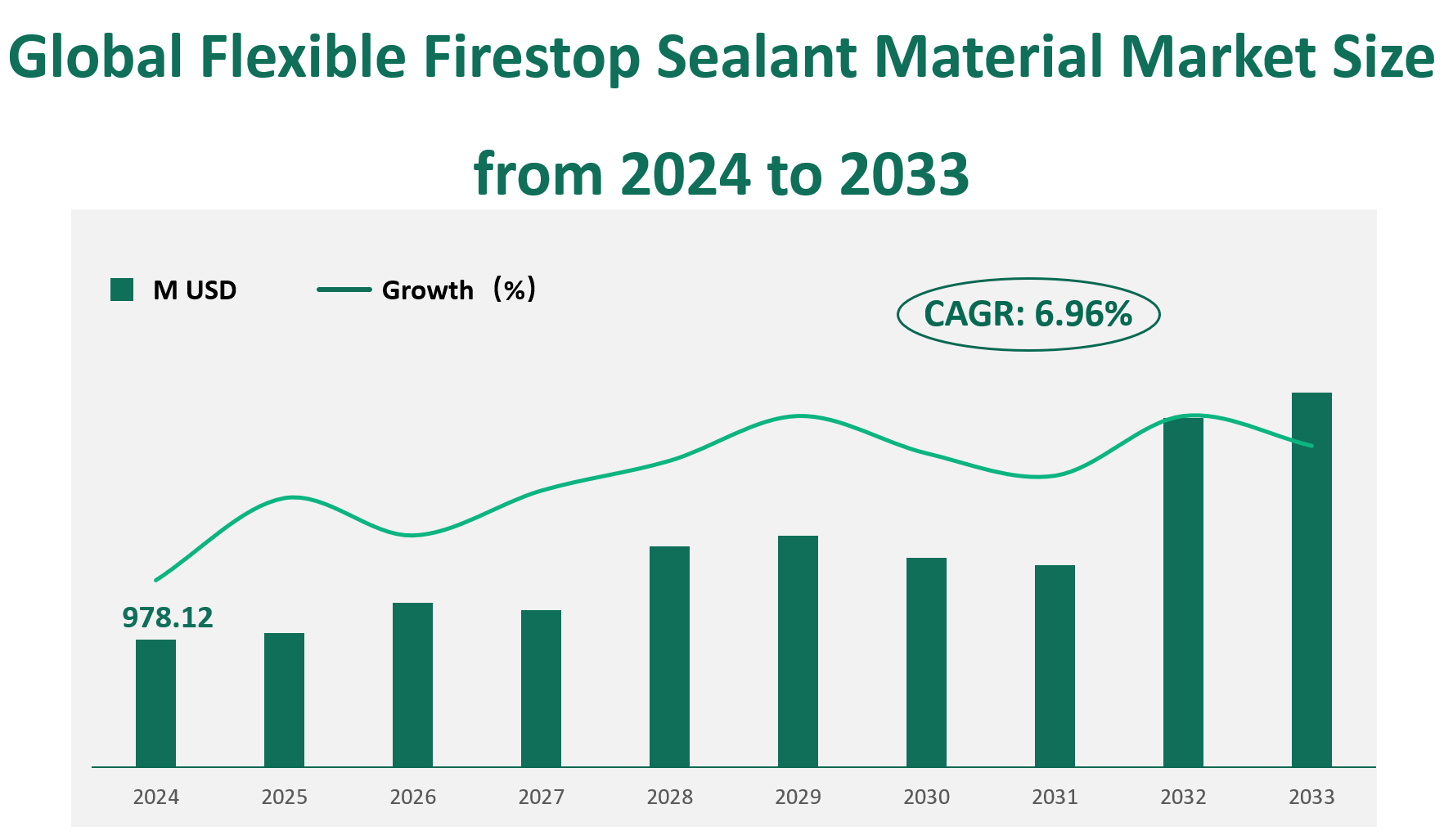1. Global Flexible Firestop Sealant Market Insight Analysis
The global Flexible Firestop Sealant market is a critical segment within the construction and safety industries, with significant growth potential. In 2024, the market is projected to reach a revenue of approximately $978.12 million. This growth is driven by a compound annual growth rate (CAGR) of 6.96% from 2024 to 2033.
Flexible Firestop Sealants are specialized materials designed to prevent the spread of fire and smoke through gaps and openings in building structures. These sealants are essential in maintaining the fire integrity of walls, floors, and ceilings, particularly in commercial and residential buildings. They are formulated to be fire-resistant, durable, and flexible, ensuring that they can withstand the dynamic conditions of modern construction while providing critical safety benefits.
Figure Global Flexible Firestop Sealant Market Size (M USD) and CAGR (2024-2033)

2. Driving and Limiting Factors of Flexible Firestop Sealant Market Growth
The growth of the Flexible Firestop Sealant market is influenced by several key drivers and limiting factors. On the positive side, the increasing awareness of fire safety and building regulations has significantly boosted demand. Governments and regulatory bodies worldwide are implementing stricter fire safety codes, mandating the use of firestop materials in new constructions and retrofits. This regulatory push has led to a surge in demand for high-performance firestop sealants.
Additionally, the rapid expansion of the construction industry, particularly in emerging economies, is a major driver. The growth of commercial and residential buildings in regions like Asia-Pacific, Latin America, and the Middle East is creating new opportunities for Flexible Firestop Sealant manufacturers. The increasing adoption of sustainable and resilient building practices is also driving the market, as firestop sealants contribute to the overall safety and longevity of structures.
However, the market faces several challenges. One significant limiting factor is the high concentration of the industry, dominated by a few major players such as 3M, Hilti, and Dow Corning. This concentration can limit market entry for new players and stifle competition. Additionally, the fluctuating prices of raw materials, such as calcium carbonate and isononyl phthalate, pose a risk to manufacturers’ profit margins. Environmental regulations and sustainability concerns are also driving the need for more eco-friendly formulations, which can be costly to develop and implement.
3. Technology Innovation and Corporate Mergers and Acquisitions in Flexible Firestop Sealant Market
Technological innovation is a key aspect of the Flexible Firestop Sealant market, with continuous R&D efforts aimed at improving product performance and expanding application scopes. Manufacturers are focusing on developing sealants with enhanced fire resistance, flexibility, and ease of application. For example, new formulations are being developed to withstand extreme temperatures and dynamic movements, ensuring long-term effectiveness in fire prevention.
Corporate mergers and acquisitions are also shaping the market landscape. Major players are leveraging strategic acquisitions to expand their product portfolios and market reach. For instance, Sika AG’s acquisition of Crevo-Hengxin in China and Bostik’s acquisition of Poliplas in Brazil are notable examples of companies expanding their footprint in high-growth regions. These acquisitions not only enhance market presence but also provide access to new technologies and production capabilities.
In addition to mergers and acquisitions, companies are also investing in digital marketing and e-commerce platforms to reach a broader customer base. The adoption of advanced manufacturing processes and automation is improving production efficiency and reducing costs, making firestop sealants more accessible and affordable.
4. Global Flexible Firestop Sealant Market Size by Type
Flexible Firestop Sealants are essential materials used in construction to prevent the spread of fire and smoke through gaps and penetrations in building structures. These sealants are designed to maintain the integrity of fire-rated walls, floors, and ceilings, ensuring that fire and smoke are contained within a specific area. The market for Flexible Firestop Sealants is segmented into two primary product types: Elastomeric Type and Intumescent Type.
Elastomeric Type sealants are designed to provide flexibility and durability in firestop applications. They are commonly used for sealing building joints, such as curtain wall gaps, to prevent the spread of fire and smoke. These sealants are known for their ability to withstand movement and vibrations without losing their effectiveness. In 2024, the revenue generated by Elastomeric Type sealants is forecasted to be approximately $552.95 million.
Intumescent Type sealants are designed to expand when exposed to heat, thereby blocking gaps and penetrations to prevent the spread of fire and smoke. These sealants are particularly effective in sealing through penetrations of single or bundled cables and are commonly used in electrical and mechanical installations. In 2024, the revenue generated by Intumescent Type sealants is forecasted to be approximately $425.17 million.
Market Share: Elastomeric Type sealants hold a larger market share compared to Intumescent Type sealants. The Elastomeric Type is expected to account for 56.53% of the total market revenue in 2024, while Intumescent Type sealants are projected to hold 43.47% of the market.
Table Global Flexible Firestop Sealant Market Size by Type in 2024
Market Size (M USD) 2024 | Market Share | |
Elastomeric Type | 552.95 | 56.53% |
Intumescent Type | 425.17 | 43.47% |
Total | 978.12 | 100.00% |
5. Global Flexible Firestop Sealant Market Size by Application
Flexible Firestop Sealants are utilized across a variety of applications, primarily in the construction sector. These applications include Residential Buildings, Commercial Buildings, Industrial Buildings, and Other applications such as agricultural, religious, recreational, and public facilities.
Residential buildings encompass a wide range of structures intended for private occupancy, including single-family homes, apartments, and condominiums. Flexible Firestop Sealants are used in these buildings to seal gaps and penetrations, ensuring that fire and smoke are contained within a specific area. In 2024, the revenue generated from Flexible Firestop Sealants used in residential buildings is forecasted to be approximately $310.05 million.
Commercial buildings include office buildings, retail spaces, and warehouses. These structures often have complex designs and require robust fire protection measures. Flexible Firestop Sealants are used to seal gaps in walls, floors, and ceilings, as well as around penetrations for electrical and mechanical systems. In 2024, the revenue generated from Flexible Firestop Sealants used in commercial buildings is forecasted to be approximately $407.43 million. This application is the largest market segment due to the extensive use of firestop sealants in commercial construction projects.
Industrial buildings are structures used for manufacturing, storage, and other industrial processes. These buildings often have high fire risks due to the presence of machinery, chemicals, and other hazardous materials. Flexible Firestop Sealants are used to seal gaps and penetrations in industrial buildings to prevent the spread of fire and smoke. In 2024, the revenue generated from Flexible Firestop Sealants used in industrial buildings is forecasted to be approximately $187.57 million.
Table Global Flexible Firestop Sealant Market Size by Application in 2024
Application | Market Size (M USD) 2024 | Market Share |
Residential Building | 310.05 | 31.70% |
Commercial Building | 407.43 | 41.65% |
Industrial Building | 187.57 | 19.18% |
Others | 73.06 | 7.47% |
Total | 978.12 | 100.00% |
6. Global Flexible Firestop Sealant Market Size by Region
North America remains the largest regional market by revenue, with an estimated $355.19 million in 2024. This region’s dominance is attributed to its stringent building codes and high demand for fire safety products in both commercial and residential constructions.
Europe follows closely with a projected revenue of $294.89 million in 2024. The European market is characterized by its focus on safety and sustainability, with countries like Germany, the UK, and France being major consumers of Flexible Firestop Sealants. The region’s growth is driven by increasing awareness of fire safety regulations and the need for advanced fire protection materials in both new constructions and retrofit projects.
China is emerging as a significant player, with an estimated revenue of $131.89 million in 2024. The rapid urbanization and infrastructure development in China are driving the demand for Flexible Firestop Sealants.
Japan is another key market, with a projected revenue of $62.08 million in 2024. Japan’s market is driven by its focus on high-quality construction materials and stringent safety regulations.
Southeast Asia is expected to generate a revenue of $26.21 million in 2024. The region is also benefiting from the adoption of advanced fire safety technologies and the increasing awareness of fire protection measures.
India is projected to reach a revenue of $23.77 million in 2024. India’s market is driven by its rapid urbanization and the increasing demand for fire safety products in both commercial and residential buildings.
Figure Global Flexible Firestop Sealant Market Size by Region in 2024

7. Global Flexible Firestop Sealant Market Analysis by Major Players
7.1 3M
Introduction and Business Overview: 3M is a multinational conglomerate headquartered in the United States, known for its diverse product portfolio, including adhesives, abrasives, and fire protection materials. The company has a strong focus on innovation and sustainability.
Products Offered: 3M offers a variety of Flexible Firestop Sealants, including elastomeric and intumescent types. Their products are designed to provide fire protection in various building applications.
Sales Revenue in 2021: 3M’s Flexible Firestop Sealant revenue in 2021 was $110.89 million.
7.2 Hilti
Introduction and Business Overview: Hilti is a Liechtenstein-based company specializing in construction products, tools, and services. The company is known for its high-quality fire protection systems and innovative solutions.
Products Offered: Hilti offers a range of Flexible Firestop Sealants, including intumescent and elastomeric types. Their products are designed to meet stringent fire safety standards.
Sales Revenue in 2021: Hilti’s Flexible Firestop Sealant revenue in 2021 was $95.24 million.
7.3 Dow Corning
Introduction and Business Overview: Dow Corning, a subsidiary of Dow, is a leading manufacturer of silicone-based products for various industries, including construction and electronics. The company is known for its innovative and high-performance materials.
Products Offered: Dow Corning offers a variety of Flexible Firestop Sealants, including silicone-based sealants that provide excellent fire resistance and flexibility.
Sales Revenue in 2021: Dow Corning’s Flexible Firestop Sealant revenue in 2021 was $65.66 million.

